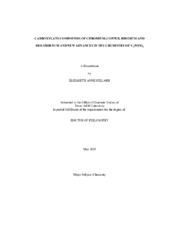| dc.description.abstract | This dissertation comprises the investigation of two subjects in the field of dimetal paddlewheel-type compounds containing metal-metal bonds: unsolvated transition metal carboxylates and triply bonded divanadium compounds. The first subject is very mature; dichromium tetraacetate was first synthesized in 1844, and hundreds of dimetal tetracarboxylates have been structurally characterized to date. A general question concerning the complexes of the type M2L4-Xn (where n = 0 to 2) is the extent to which the M-M distances are influenced by the presence of axial ligands, X. However, virtually none of the carboxylato complexes crystallize without axial ligands. In the solid state, in the absence of a coordinating solvent, the dimetal units often act as axial ligands to one another. In order to exclude axial coordination, both from donor solvent molecules, and from the aggregation of M24+ units, we have successfully used the bulky 2,4,6-triisopropylbenzoate ligand to bridge the dimetal core. We have investigated the triisopropylbenzoato complexes of some metals which are known for their ability to form a vast array of tetracarboxylato complexes, namely chromium, copper, molybdenum, and rhodium, and have found that these novel compounds display some interesting structural and chemical properties.
The second subject of this dissertation is much more contemporary. Although compounds containing multiple bonds between metal atoms have been known since 1964, the first triply-bonded divanadium compound was not synthesized until 1992, and only two additional compounds of this type have been made in the intervening ten years. In order to extend this chemistry, several additional compounds containing a triply bonded V24+ core have recently been characterized. In our study of these compounds, we have discovered the first example of a stable paddlewheel-type compound with a M23+ core. | en |


